S&P Global Offerings
Featured Topics
Featured Products
Events
S&P Global Offerings
Featured Topics
Featured Products
Events
S&P Global Offerings
Featured Topics
Featured Products
Events
S&P Global Offerings
Featured Topics
Featured Products
Events
Language
Featured Products
Ratings & Benchmarks
By Topic
Market Insights
About S&P Global
Corporate Responsibility
Diversity, Equity, & Inclusion
Featured Products
Ratings & Benchmarks
By Topic
Market Insights
About S&P Global
Corporate Responsibility
Diversity, Equity, & Inclusion

Published: April 1, 2022
By Melanie Posey and Katie Darden
Highlights
Overall job satisfaction is high among women in tech, with 53% of respondents reporting that they are very satisfied in their current positions, while 39% say they are somewhat satisfied.
Just over half of respondents expect things to get better for women at their organizations in the next year. Younger women were more likely than those aged 45 or older to be optimistic about the changes on the horizon and to think that conditions for women had improved over the previous year.
Workplace flexibility should be at the top of the list for companies seeking to attract and retain a diverse tech workforce. More than 57% of survey respondents identified flexible work hours and remote work as a key driver of job satisfaction.
More than 50% of respondents said that seeing women role models in senior leadership positions is an important factor in career satisfaction.
Despite the high satisfaction levels, there is still work to do to improve company culture. One in three of respondents has experienced sexual harassment at work. Many more women reported experiencing inequitable pay and advancement opportunities, as well as exclusion from important projects and social networks at work.
Women’s experiences in the technology workplace are many and varied and research directors Katie Darden and Melanie Posey join host Eric Hanselman to explore the results of the Women in Technology study. Produced in collaboration with the California Technology Council and WE Global, it looks at different aspects, including the power of virtuous circles that women role models can create in tech and how perspectives differ across age groups. Important insights with some surprises! Share and listen to Next in Tech here.
Jobs reports and daily headlines about the Great Resignation suggest that much of the U.S. workforce is on the move. Influenced by the COVID-19 pandemic and many other factors, people across the country have been reshaping their personal and professional lives over the last few years.
Meanwhile, organizations around the world are increasingly embracing the importance of making meaningful progress on diversity and inclusion, whether as part of a broader ESG strategy, as an added dimension of smart human capital management, as a way to enhance competitiveness in the digital economy, or all of the above.
Recognizing the potential impacts of these forces at play in labor markets and the ESG landscape, S&P Global Market Intelligence collaborated with the California Technology Council and WE Global Studios to conduct a fourthquarter 2021 survey of U.S. women working in technology. Our respondents come from a variety of industries, but all work in technology roles — either as information technology (IT) practitioners or in tech-aligned line-of-business roles. We wanted to investigate key drivers of career satisfaction and dissatisfaction for women in tech and to help companies identify strategies for creating more inclusive and productive cultures.
Our survey results were in some ways surprising. Between the recent discourse around the Great Resignation and years of anecdotes highlighting the challenges facing women working in tech, we did not anticipate the high levels of job satisfaction that our survey respondents reported. However, it was also surprising (and disappointing) to see the extent to which otherwise satisfied women in tech still experience day-to-day inequities, microaggressions and outright hostility in the workplace.
This leads to another set of questions. What are companies doing right when it comes to attracting and retaining tech talent? Where is there room for improvement? In which areas of tech are the prospects most promising for women? What experiences — positive and negative — shape the landscape for women in tech today? Which of those experiences seem most likely to make or break a woman’s relationship with her employer?
Our study aims to help organizations dig deeper to identify the action items and strategies that will help them stand out in a competitive market for highly skilled tech talent. As the economy (along with our work and personal lives) becomes ever more digital, business success requires digital transformation. Therefore, the people building the technology, developing the applications, and designing the user interfaces must reflect the diversity of the target customers whom digital businesses seek to engage.
The 2021 inaugural Women in Technology survey provides a better understanding of the nuances of gender in the workplace, specifically in the IT sector. S&P Global Market Intelligence conducted the study in partnership with the California Technology Council and WE Global Studios.
Data points from the survey include companies’ formal commitments or programs for increasing workplace diversity and inclusion, job satisfaction, retention and representation of women in IT and senior leadership roles. The survey results illustrate the structural and cultural factors that influence women’s ability to achieve their full potential as technology industry leaders. Analysis of the survey results yields action items companies can implement to tap into an increasingly diverse pool of IT talent and create a more inclusive and equitable workplace environment for women in tech.
This online survey of 626 U.S. women working in technology was conducted from November 2 to December 20, 2021. The margin of error for topline statistics is +/- 4 pts at the 95% confidence level. Base sizes below n=30 should be interpreted anecdotally.
Due to survey routing, qualification criteria, attrition and other factors, some questions were not answered by the full sample of respondents.
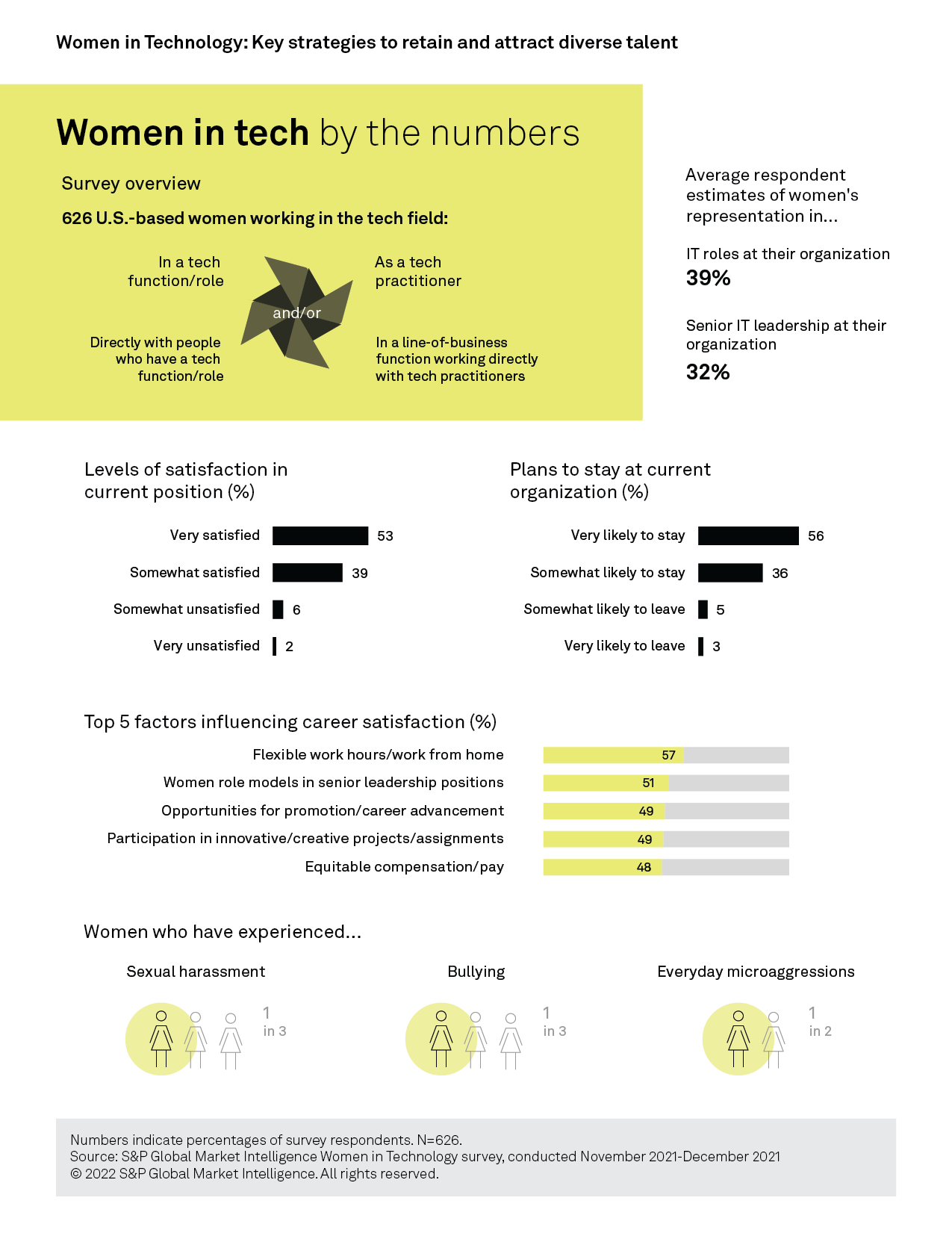
Flexibility should be at the top of the list for companies seeking to attract and retain a diverse tech workforce. Diversity, compensation and a healthy company culture are also very important for women in tech. But tradeoffs in other categories might be acceptable to employees for whom flexibility, remote work options and work-life balance are key determinants of job satisfaction. These factors have an even more universal appeal than one might expect. Far from being limited to women with children at home, workplace flexibility is a top priority across the board for women in tech.
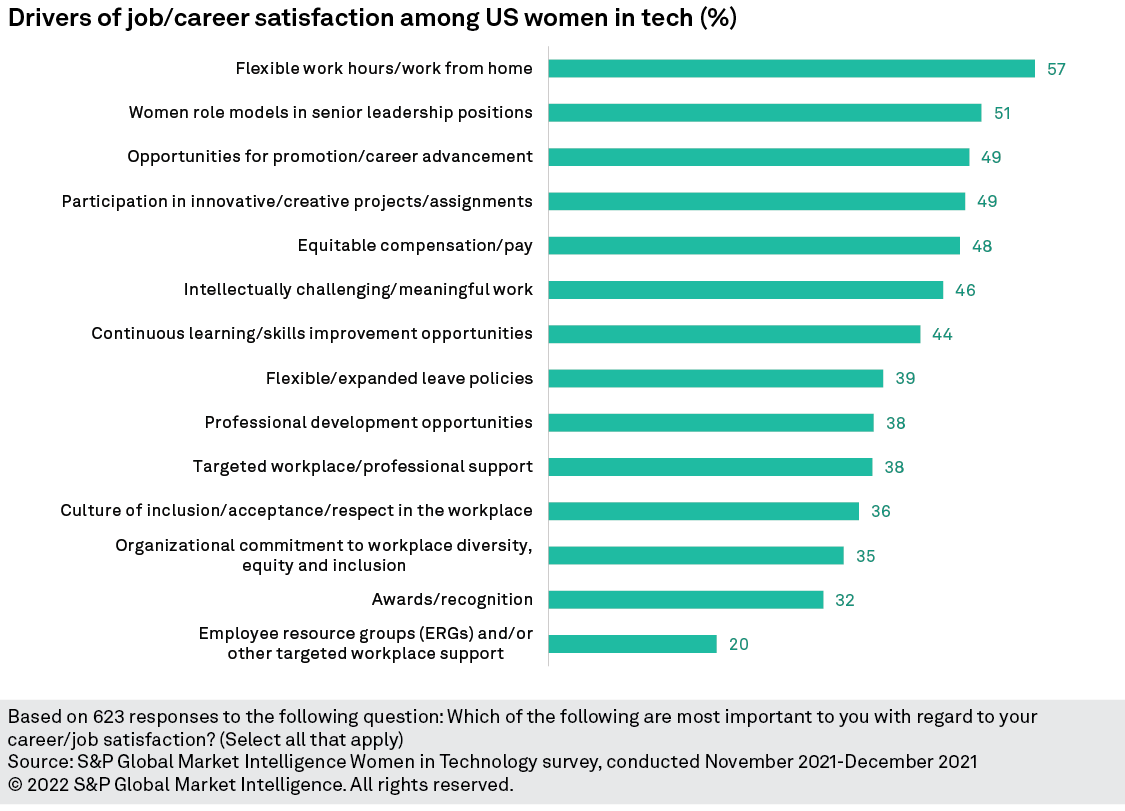
Our survey results suggest a relatively high sense of optimism among women in tech. More than 51% of respondents said they expect things to improve for women at their organizations over the next year, compared to 39% who saw improvement in the past year. However, levels of optimism varied by age. In the under 45-year-old age group, 44% of women were positive about changes over the past year, while 56% were optimistic about the coming year. That compares to 23% and 36%, respectively, for women aged 45 or older.
The COVID-19 experience likely influences what we heard from Women in Tech survey respondents. The survey took place at a relatively hopeful point in the pandemic. The U.S. was between the peaks of the Delta and Omicron variants, although cases were already beginning to climb rapidly as the survey wrapped up. Also by that time, many U.S. adults had long since received COVID-19 vaccines, and many children were beginning the vaccination process. Meanwhile, pandemic-era measures such as remote work were still in place at many companies.
The top driver of job satisfaction among our respondents was flexible working hours and the ability to work remotely. That tech employees prize workplace flexibility is not surprising, particularly as we enter the third full year of the COVID-19 pandemic. One might even expect women, who tend to bear more caregiving responsibilities at home, to especially favor flexible work arrangements.
But our study showed that flexible working conditions are not just important for caregivers. In fact, women without children at home were more likely to identify flexible work hours and working from home as one of the most important drivers of job satisfaction, at 64%, versus 53% for respondents with at least one child living in their household.
As companies explore return-to-office scenarios, our survey results suggest that decision makers should consider both the importance of workplace flexibility across the entire employee population and the extent to which pandemic-era changes should become the new normal.
The COVID-19 pandemic accelerated digital transformation by making all of our lives (and the economy) more digital. Workforce diversity in tech is not negotiable because the people developing the apps, building the technology and designing the UIs need to reflect the diversity of what is increasingly becoming a digital world.
Survey results suggest real progress in IT gender diversity over the last few years. This is helpful context for understanding the levels of satisfaction and optimism detected in our recent study.
Respondents to the Women in Tech survey estimated, on average, that women hold about 39% of IT roles in their organization. That compares to the 27% average reported by respondents to 451 Research’s Voice of the Enterprise (VoTE): Digital Pulse survey conducted in the second quarter of 2019. These studies surveyed different populations, but the difference in the numbers seems to indicate a clear trend toward greater representation of women in IT. Women in Tech survey respondents who indicated dissatisfaction in their positions were more likely to work for companies where women’s estimated representation in IT roles was 10% or less.
Women in Tech survey respondents estimated, on average, that women hold 32% of senior IT leadership roles at their organizations, compared to an average of 23% reported in 451 Research’s VoTE: Digital Pulse, Organizational Dynamics survey in 2019. More than half of our respondents indicated that seeing women role models in senior leadership positions is a key driver of job satisfaction.
Respondents expect conditions for women to continue improving
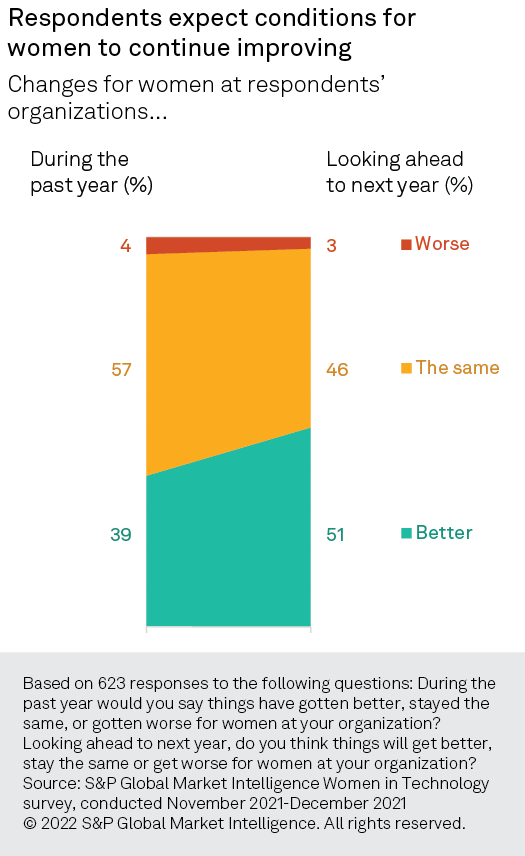
For companies that do not already have many — or any — women in senior leadership positions, the question arises of how to rectify that. Successful organizations will reap the benefits of diversity that stem from wider ranges of ideas, assumptions and lived experiences among their employees. Organizations that do so are likely to be those that create a virtuous cycle by building a diverse talent pipeline at various levels, rather than bemoaning the lack of “diverse” candidates for senior positions.
More than 28% of Women in Tech survey respondents said their organizations had formal diversity and inclusion-related commitments or programs in place; another 31% said their organizations were developing such initiatives. Women in our study were much more likely to be highly satisfied in their positions if they worked at organizations where diversity and inclusion initiatives were at least in the development stage.
More than two-thirds of our survey respondents appear likely to stay in the tech field, either remaining with their current employer, seeking another ITrelated job elsewhere, starting their own IT-related business or leaving to pursue further IT-related education.
About 22% of respondents said they were passively looking to change employers, while nearly 18% said they were actively looking. We asked those respondents, along with those who were willing to change but not currently looking at other jobs, what their next career move might be. More than half (53%) were likely to stay in the IT field, either moving to another organization, starting their own IT business or pursuing further IT-related education.
This could be both good news and not-so-good news for companies seeking to retain talented women in tech. The good news is the relatively high retention rate implied by our study, with more than 82% of respondents not actively looking for a change in employment. The less than good news is that most women who do leave are likely to take their expertise to a competitor, or even become competitors themselves.
In all, about 61% of respondents said that they were either unwilling to change employers or that they were willing to change but not looking for other jobs. We asked those respondents about why they were likely to stay with their current employers. More than half (51%) identified work-life balance as a factor influencing that decision. No other factor was chosen by a majority of women in response to this question, although close to 46% pointed to respect from colleagues and customers as being important.
While women are more present than ever in technology roles and report high levels of job satisfaction, the prevalence of problematic workplace cultures and persistence of inappropriate behavior indicate that there is still work to be done for women to feel valued and safe at work. Getting a seat at the Higher satisfaction levels at organizations where women are well represented in IT
table is only half the battle — the other half involves making sure everyone’s table manners meet certain standards.
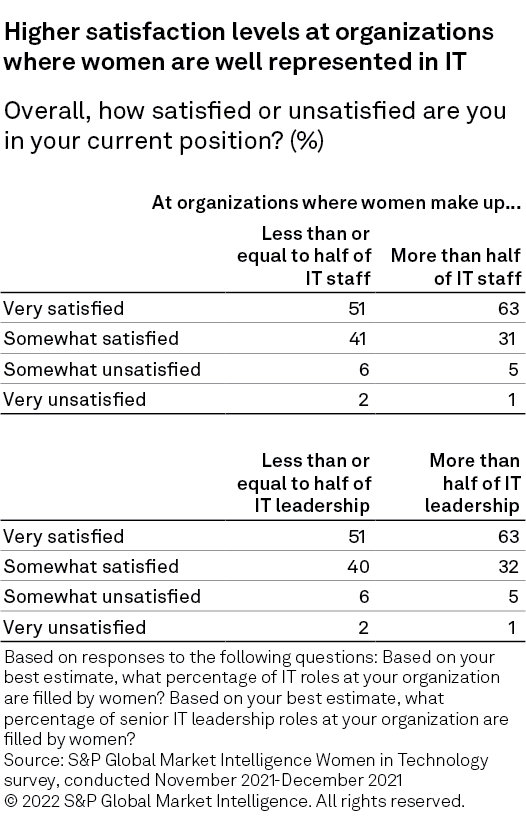
We asked respondents whether they had experienced certain behaviors/situations during their careers and asked about the frequency (often/occasionally/ seldom/never). One in three of our survey respondents has experienced sexual harassment at work, and a similar proportion has had to deal with bullying at some point. Fewer than half of respondents (48%) say they are very comfortable speaking up if they see or experience discrimination or harassment at work. Other behaviors related to compensation and advancement were also worryingly common: similar proportions (around 55%) of women surveyed reported having the experience of men being paid more for doing the same job, men receiving credit for women’s work and ideas, and exclusion from key strategic projects. More than half of women in our survey also reported having had to deal with day-to-day microaggressions and inappropriate language at some point in their careers. This is the case across all age cohorts, but particularly for respondents in the 45-to-54-year-old demographic.
Because we do not have pre-pandemic data as a benchmark, it is difficult to gauge precisely whether the experience of virtual workplace culture for U.S. women in tech has been better or worse than the physical workplace equivalent when it comes to problematic behaviors and situations. Our assumption is that the events of 2020 in their totality — the global pandemic as well as racial/social justice, political, and economic issues — served as a call to action for many companies, leading to expanded or intensified commitments to diversity and inclusion initiatives. As employees start to return to the office (for some of the time at least), we will see what “return to normal” really looks like.
Top 10 factors influencing women’s plans to remain with current employer (%)
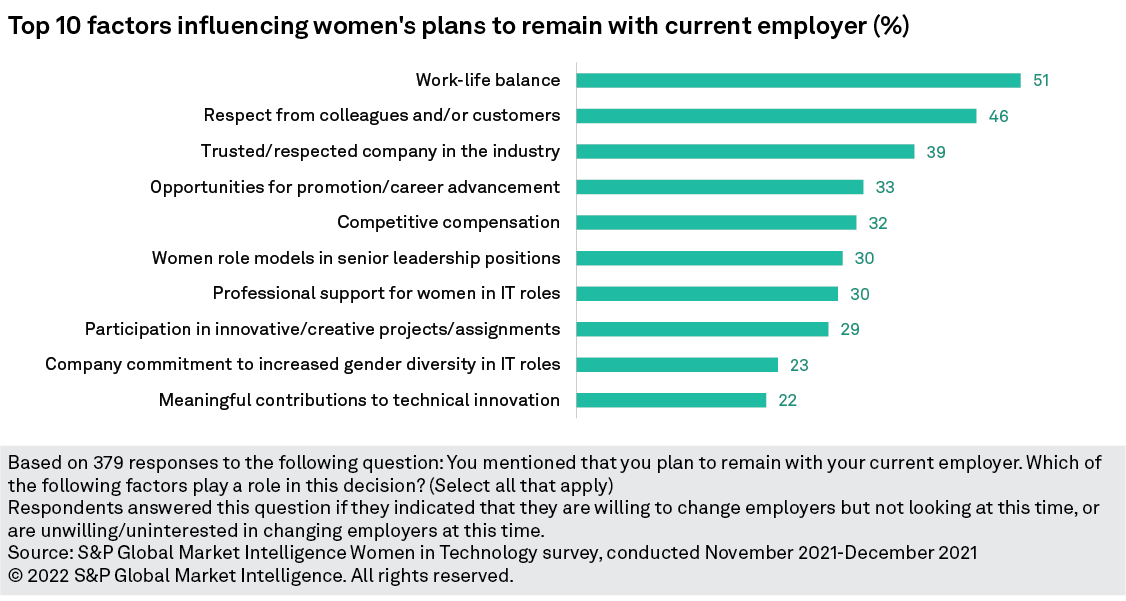
The last few years have been difficult on many levels for people and organizations worldwide, but they have also led to conditions that partly explain relatively high job satisfaction levels among U.S. women working in technology. The global pandemic has made flexible and remote work arrangements common in the tech space, normalizing one of the factors that can lead to improved work-life balance. The women we surveyed value flexible working options very highly, and as the so-called Great Resignation continues, our survey results confirm a trend of organizations recognizing the employee retention impact of improved support for working parents and caregivers.
The pandemic years have also accelerated digital transformation, which has elevated the importance of diversity at the tech table. Advances in gender diversity in IT leadership ranks reflect improved representation of women in tech overall, particularly in transformation-oriented IT areas that drive the digital economy. Those areas include software development and engineering, as well as data and application management. Since customer experience rules in the digital economy, organizations may be making good on a realization that the people developing and implementing the technology should better reflect the composition not just of society, but also potential customers, partners and suppliers.
It will be up to individual organizations to accelerate the trends that drive tech employees’ career satisfaction and optimism for the future, while continuing to root out negative aspects of workplace culture. Work-life balance is a primary consideration for women who plan to stay with their current tech roles, and for some people that balance is easier to maintain while working remotely. As companies across industries vie for tech talent and strive to accelerate innovation, they should pay close attention to the policies and cultural factors that create the best possible conditions for enthusiastic employee engagement.
Experiences of everyday inequities and microaggressions (%)
During your career, how often – if at all – do you experience any of the following while at work, including business trips, organized events, and work-related activities outside the office (e.g., dinners, drinks, golf)?
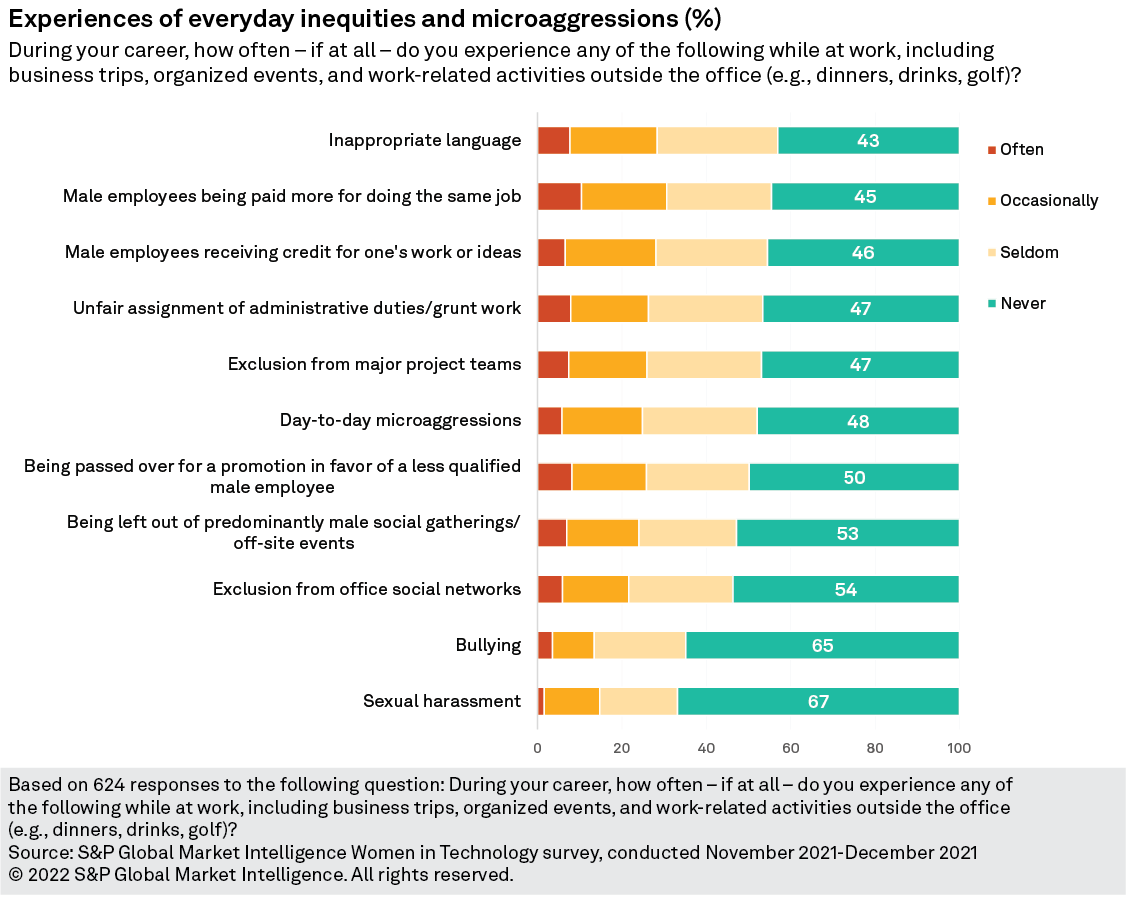
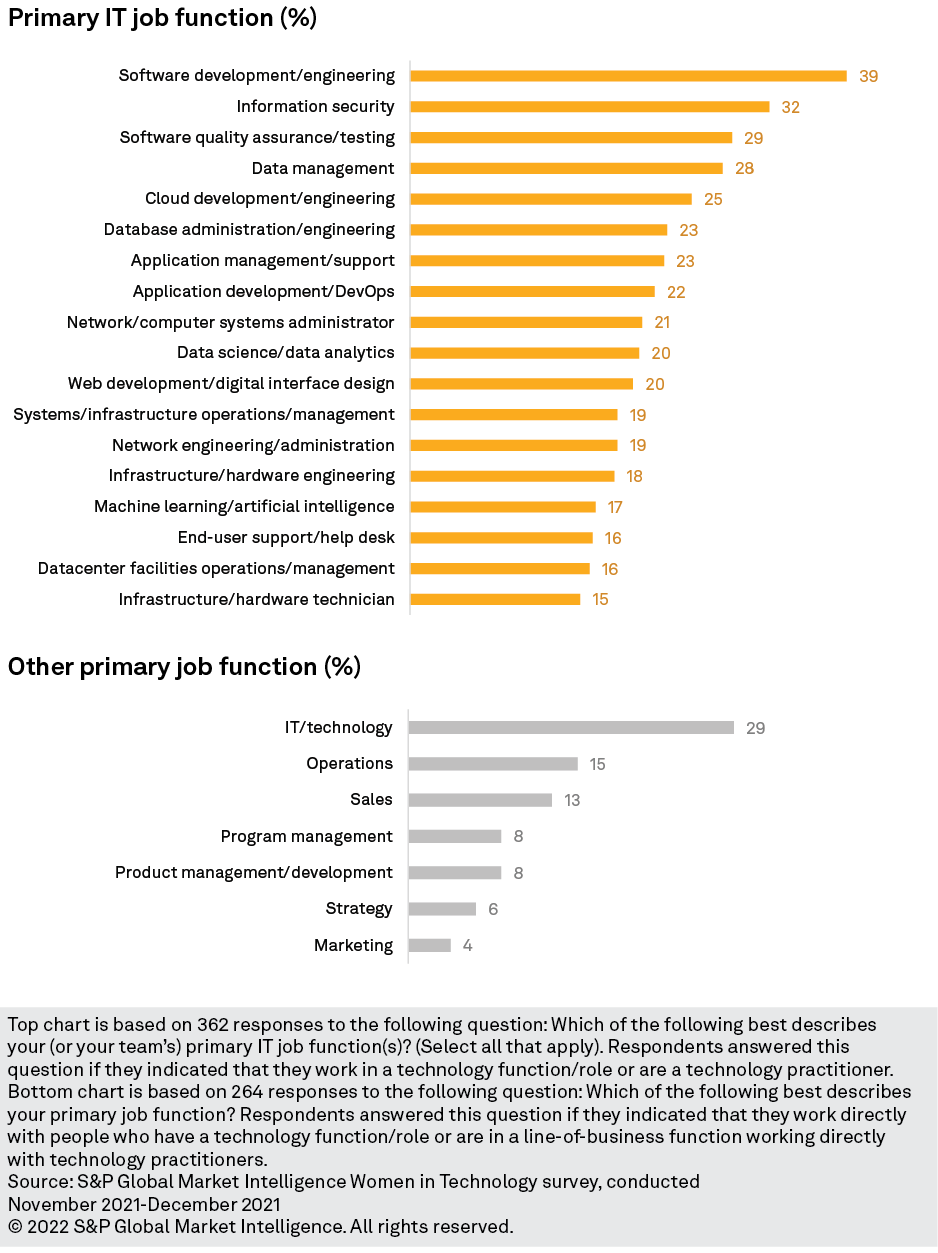
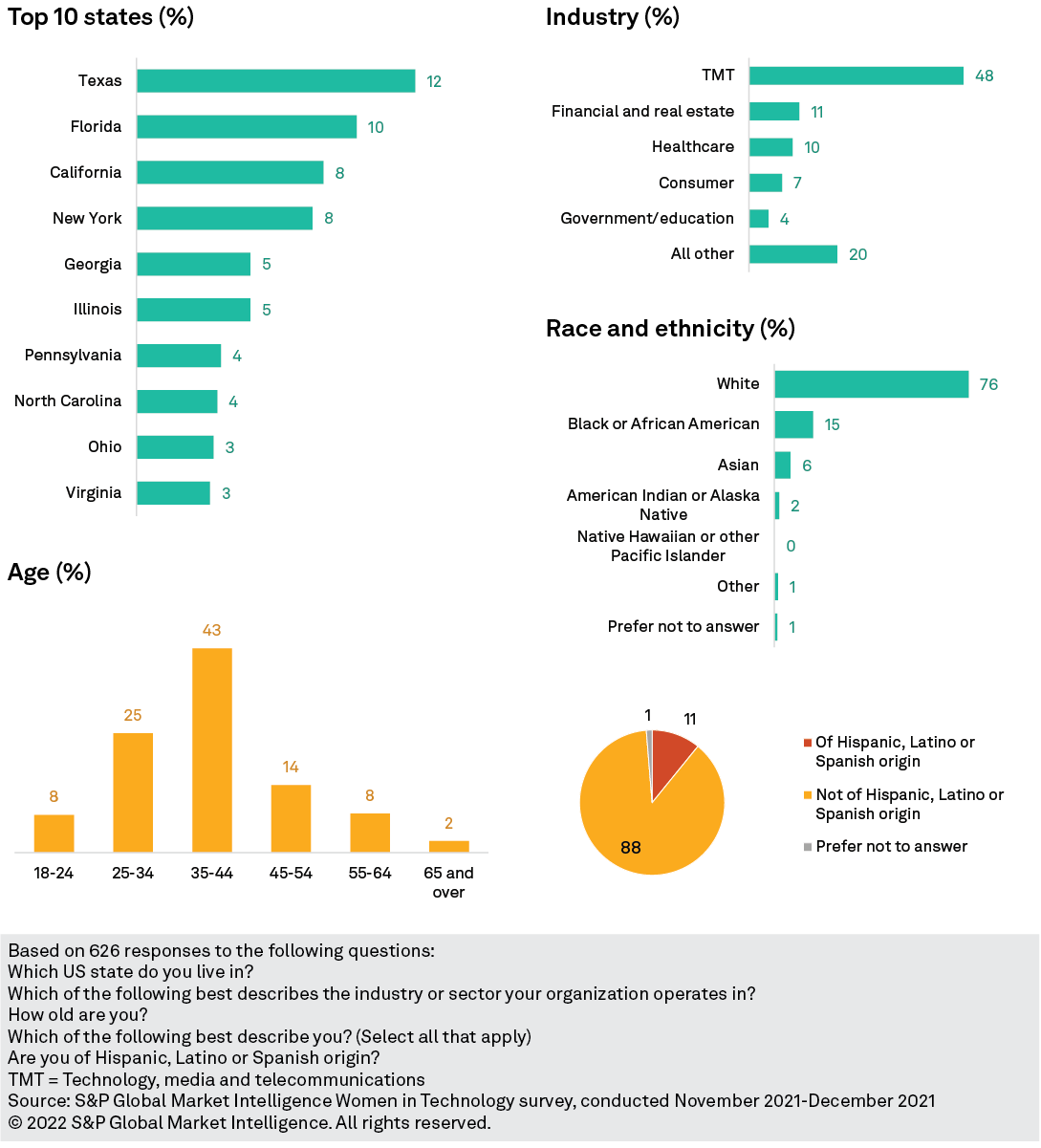
“Voice of the Enterprise: Digital Pulse, Diversity & Inclusion 2021 — Advisory Report,” 451 Research, October 2021
“Progress toward corporate diversity requires more than ticked boxes and token hires,” S&P Global, February 2022
“COVID-19 Could Rapidly Expand Family-Leave Policies; It Could Also Deal A Serious Blow
To Women In The Workforce,” S&P Global and AARP, October 2020
“Companies Expand Family-Friendly Policies, But Focus Favors Parents Over Caregivers,” S&P Global and AARP, December 2020
Melanie Posey is the Research Director for the Cloud & Managed Services Transformation at 451 Research, a part of S&P Global Market Intelligence. In addition to managing the research team, she focuses on analyzing the evolution of enterprise IT through the lens of cloud and the associated transformation of IT consumption and delivery models. Melanie also manages 451 Research’s Voice of the Enterprise: Cloud, Hosting & Managed Services offering.
Katie Darden is Research Director for the S&P Global Market Intelligence financial institutions industry research group, which covers the banking, insurance and financial technology sectors. As leader of S&P Global’s Diversity in the Markets Research Lab, Katie also specializes in research on diversity, equity and inclusion, particularly on topics related to gender diversity in the global business community.
At S&P Global Market Intelligence, we know that not all information is important—some of it is vital. Accurate, deep and insightful. We integrate financial and industry data, research and news into tools that help track performance, generate alpha, identify investment ideas, understand competitive and industry dynamics, perform valuation and assess credit risk. Investment professionals, government agencies, corporations and universities globally can gain the intelligence essential to making business and financial decisions with conviction. S&P Global Market Intelligence is a division of S&P Global (NYSE: SPGI), which provides essential intelligence for individuals, companies and governments to make decisions with confidence. For more information, visit www. spglobal.com/marketintelligence.
Copyright © 2022 by S&P Global Market Intelligence, a division of S&P Global Inc. These materials have been prepared solely for information purposes based upon information generally available to the public and from sources believed to be reliable. S&P Global Market Intelligence, its affiliates, and third party providers (together, “S&P Global”) do not guarantee the accuracy, completeness or timeliness of any content provided, including model, software or application, and are not responsible for errors or omissions, or for results obtained in connection with use of content. S&P Global disclaims all express or implied warranties, including (but not limited to) any warranties of merchantability or fitness for a particular purpose or use.
S&P Global Market Intelligence’s opinions, quotes and credit-related and other analyses are statements of opinion as of the date they are expressed and not statements of fact or recommendation to purchase, hold, or sell any securities or to make any investment decisions, and do not address the suitability of any security.
S&P Global keeps certain activities of its divisions separate from each other in order to preserve the independence and objectivity of their respective activities. As a result, certain divisions of S&P Global may have information that is not available to other S&P Global divisions.
S&P Global provides a wide range of services to, or relating to, many organizations. It may receive fees or other economic benefits from organizations whose securities or services it may recommend, analyze, rate, include in model portfolios, evaluate, price or otherwise address. www.marketintelligence.spglobal.com
